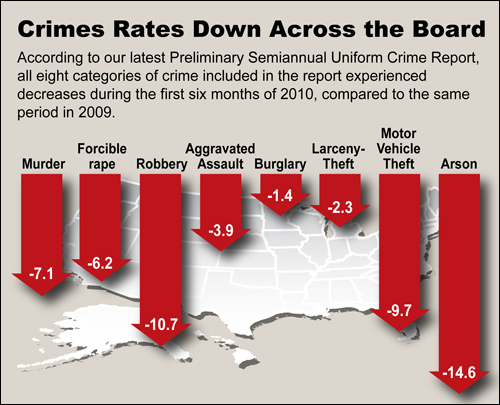We’ve just released our first peek into crime in 2010—with a snapshot of the first six months of the year.
The early returns are encouraging. According to the Preliminary Semiannual Uniform Crime Report, January-June, 2010, the nation saw a 6.2 percent decrease in the number of reported violent crimes and a 2.8 percent decrease in the number of reported property crimes compared to data for the same time frame during 2009.
The report specifically covers the violent crimes of murder, forcible rape, robbery, and aggravated assault…and the property crimes of burglary, larceny-theft, and motor vehicle theft. It also includes arson, which is considered a property crime but is tracked separately for this report.
Some of the preliminary findings:
-Reported incidents of violent crime as a whole decreased in all four regions of the country—falling 0.2 percent in the Northeast, 7.2 percent in the Midwest, 7.8 percent in the South, and 7.2 percent in the West.
-In the Northeast, reported incidents of murder were up 5.7 percent, forcible rapes were up 1.1 percent, and aggravated assaults were up 2.4 percent.
-Reported incidents of property crime as a whole declined in all four regions of the country—dropping 0.2 percent in the Northeast, 2.5 percent in the Midwest, 3.6 percent in the South, and 3.1 percent in the West.
-In the Northeast, however, reported incidents of burglary rose 3.9 percent.
-Population-wise, cities with 500,000 to 999,999 residents saw the greatest decline in reported violent crimes (8.3 percent) and in property crimes (4.8 percent).
Since 1930, the FBI has been tasked with collecting, publishing, and archiving reliable uniform crime statistics for the nation. Our hope is that this report will continue to assist community leaders and law enforcement managers with formulating crime-fighting and crime prevention strategies.
Last month, we released a new tool to help these leaders and others analyze crime statistics over the past half-century. The UCR Data Tool, as it’s called, enables users to perform queries on custom variables like year, agency, and type of offense. Until now, making comparisons of our crime data required searching the annual reports and then manually crunching the numbers. The data from the just-released report is not included in the new tool, since it is preliminary and represents only a partial year.
Although many of the crimes reported in our UCR statistics fall primarily under state and local jurisdiction, the FBI continues to work closely with our law enforcement partners on numerous joint task forces around the country and to offer a range of services and support. A few examples include:
- Information services like the National Crime Information Center
- Fingerprint and other types of forensic identification services, such as our Integrated Automated Fingerprint Identification System and the Combined DNA Index System.
As always, we caution against drawing conclusions about specific locations by making direct comparisons between cities. Valid assessments are only possible by carefully analyzing the range of unique conditions affecting each local law enforcement jurisdiction.








No comments:
Post a Comment